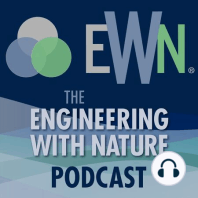2 min listen

Part 1: EWN's Synergies with the World Bank's Approach to Natural Infrastructure
Part 1: EWN's Synergies with the World Bank's Approach to Natural Infrastructure
ratings:
Length:
27 minutes
Released:
May 12, 2021
Format:
Podcast episode
Description
In 2020, natural hazards like storms, floods, droughts, and wildfires caused more than $200 billion in damage worldwide and the death of 8,000 people. Since 1980, there have been 285 weather and climate-related disasters in the United States alone that have produced at least $1 billion in damage. In this two-part episode, we’re talking with Dr. Todd Bridges, Senior Research Scientist for Environmental Science with the U.S. Army Corps of Engineers and National Lead for Engineering With Nature®, and Dr. Brenden Jongman, Senior Disaster Risk Management Specialist with the World Bank’s Global Facility for Disaster Reduction and Recovery (GFDRR). Todd and Brenden discuss the World Bank’s approach to using natural infrastructure solutions to address some of the most pressing climate change challenges and the synergies with Engineering With Nature’s approach of using innovative natural and nature-based solutions. The World Bank’s increasing support in this area has recently been recognized by the World Resources Institute as one of their top outcomes of 2020 in their work with key partners. The World Economic Forum estimates that by midcentury, $100 trillion dollars will be invested in infrastructure worldwide. In its role as an international financier, the World Bank’s overall objective is to end extreme poverty and build shared prosperity around the world. Climate change and natural hazards are strongly linked to poverty as the poor are often the most vulnerable. As Brenden notes, often a single natural disaster can push a family below the poverty line. The World Bank estimates that climate change will push an additional 100 million people globally into poverty in the coming years. As Todd and Brenden discuss, natural infrastructure is an important part of the solution to addressing multiple hazards, including those intensified by climate change, and creating community resilience. Natural infrastructure often has significant benefits over traditional concrete and rock infrastructure. Building a coastal park to provide flood risk management benefits can also create jobs and recreation opportunities, reduce heat island effects, provide trees that absorb carbon and contribute to achieving climate change targets, and provide much needed opportunities for nature experiences in urban settings. The World Bank is making an estimated $1 billion in annual investments in projects applying nature-based solutions—a 20% increase since 2018. Their guidance, Integrating Green and Gray: Creating Next Generation Infrastructure and Implementing Nature-Based Flood Protection: Principles and Implementation Guidance, emphasizes the need to consider both conventional engineering and nature-based solutions in a more systematic way. They have been applying that approach in projects around the world for over a decade. The World Bank’s Nature-Based Solutions (NBS) Community of Practice, and internal knowledge hub, was established in 2017 with support from the GFDRR. This year, the World Bank and GFDRR will launch a dedicated Global Program on NBS for Climate Resilience, to further scale up the knowledge, investments, and partnerships on NBS across the World Bank’s global activities. As examples, Brenden talks about his experience in Madagascar and Mozambique. Madagascar is experiencing rapid, unplanned urbanization in a floodplain that is prone to more frequent and more extreme flooding due to climate change. In Mozambique in 2019, the rapidly growing coastal city of Beira faced one of the worst cyclones to hit the African continent. The World Bank’s work with the government of Mozambique on various initiatives, including development of one of the largest urban parks on the African continent, is strengthening the city’s resilience. Todd reinforced the need for integrating conventional and nature-based engineering, noting the challenges that we're experiencing are very complex and really call for a diversified set of solutions that we can draw toge
Released:
May 12, 2021
Format:
Podcast episode
Titles in the series (82)
Engineering With Nature - EWN: Over the last 10 years, the U.S. Army Corps of Engineers has been working on an initiative called Engineering With Nature that uses natural processes and systems to deliver a broad range of economic, environmental, and social benefits. EWN, as... by EWN - Engineering With Nature